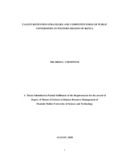| dc.contributor.author | CHIMWENE, MILDRED L. | |
| dc.date.accessioned | 2020-10-27T10:09:13Z | |
| dc.date.available | 2020-10-27T10:09:13Z | |
| dc.date.issued | 2020-08-17 | |
| dc.identifier.uri | http://r-library.mmust.ac.ke/123456789/1392 | |
| dc.description.abstract | Public Universities are currently facing challenges in retaining talent. This has been crucial to the changing prospects and potentials of knowledge formation and learning. Organizations loose key talent for many reasons; lack of job satisfaction, poor reward systems and management, poor organizational policies, lack of opportunities for growth, training and development, lack of work life balance with regard to work life conflicts and poor working conditions. Retention of employees has become agreater challenge facing human resource practitioners' in organizations.The purpose of the study was to examine talent retention strategies and competitiveness of public universitiesin Western Region of Kenya. This studydeterminedthe effects of work life balances on competitiveness of Universities, analysed the influence of training and development on Competitiveness in public Universities and determined the effects of rewards systems on competitiveness in public universities in Western Region of Kenyaand lastly examined the joint effect of talent retention strategies on competitiveness of public Universities in Western Region of Kenya. Competitiveness was measured by students’ enrolment and webometrics ranking. Literature was reviewed on the constructs of talent retention strategies and competitiveness of public universities and the study is based on Resource Based View (RBV) theory. This study is expected to benefit organizations in coming up with policies that will improve talent retention rates and it will also add knowledge to academic consortium on talent retention strategies in Universities. The study area was public universities in Western Region of Kenya namely; MasenoUniversity, Masinde Muliro University of Science &Technology, Jaramogi Oginga Odinga University of Science & Technology and Kibabii University. The research adopted co-relational research design. Sampling techniques were stratified samplingand proportionate samplingwhereby each university formed a strata and population was further grouped into academic and non teaching staff. Pre-test of the questionnaire was carried out in Kaimosi Friends University College to enable the researcher to ascertain the validity and reliability of the instrument. Data was collected by use of structured questionnaire. Validity of research instruments was determined using content and constructs validly. Data was analyzed using descriptive and inferential statisticsand Statistical Package for Social Sciences (version 25)was used for data analysis.The questionnaires were given to 351 respondents out of which 316 respondedwhich represents90% of the respondents. The findings of this study established that work-life balance, training and development and reward systems affects competitiveness of Universities in western region of Kenya and thereforejoint talent retention strategies are vital for Universitiesachieving University competitiveness. Null hypotheses for all the four objectives wererejected and alternate hypotheses accepted. This study recommends that universities in Western Region in Kenya should come up work life balance programs, embrace training and development practices and establish reward systems that are effective in order to be able to retain their talent which in turn affects competitiveness of Universities.The results ofthis study have significant implication on strategic talent retention strategies and its effect on competitiveness of Universities and also theoretical implications. | en_US |
| dc.description.sponsorship | MMUST | en_US |
| dc.language.iso | en | en_US |
| dc.publisher | MMUST | en_US |
| dc.subject | Talent, Retention, Strategies, Competitiveness, Public Universities, knowledge, policies,opportunities. | en_US |
| dc.title | TALENT RETENTION STRATEGIES AND COMPETITIVENESSOF PUBLICUNIVERSITIES IN WESTERN REGION OF KENYA | en_US |
| dc.type | Thesis | en_US |

